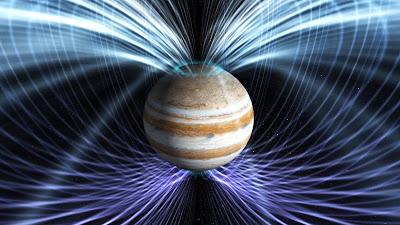 |
| NASA’s Juno spacecraft will create a detailed map of Jupiter’s magnetic field. |
NASA’s
Juno spacecraft will enter orbit around the gas giant planet, Jupiter, on
July 4, 2016. Juno’s mission is to understand the origin and evolution of
Jupiter, map its magnetic field, look for a solid planetary core, measure water
and ammonia in deep atmosphere, and observe auroras.
Jupiter is the largest planet in our solar system and has a
massive magnetosphere. A magnetosphere is the result of the collision between a
planet’s intrinsic magnetic field and the supersonic solar wind. Juno will use
a pair of magnetometer sensors to map the magnetic field and explore the entire
three-dimensional space around Jupiter. They hope to find how the magnetic
field is generated.
NASA is sending the Juno spacecraft to Jupiter, to peer beneath its cloudy surface and explore the giant planet's structure and magnetic field. Juno's twin magnetometers, built at Goddard Space Flight Center, will give scientists their first look within Jupiter at the powerful dynamo that drives its magnetic field. In this interview, Deputy Principal Investigator Jack Connerney discusses the Juno mission and its magnetometers.
Credit: NASA/Goddard/Daniel Gallagher
Artist concept depicting Jupiter's vast magnetosphere as it would appear in Earth's sky, with the Moon included for scale.
No comments:
Post a Comment